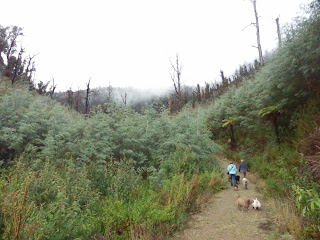The day after our big
walk at Marysville, Penny refused to go for a walk along the Yarra at
Warburton, one of her favorite places, so I popped her back into the car and went home to investigate.
To my dismay I realised that both her front paws were raw and weeping on the pads. What could have happened? I'm still mystified. I wonder if she might have rubbed them raw on the new gravel path to Steavenson Falls? Or perhaps she skinned them on the grid she walked over.
But if that were the case, surely the other dogs would also have sore paws, and I haven't heard that they do.
Perhaps her feet were hurting and Penny licked them raw. We have noticed her licking her feet recently (before that walk).
I bandaged the paws
and settled down near Penny with a good novel - a great read, actually. It was
The Devil You Know, by Mike Carey. In that way I could sit watching her and constantly check she was not licking the bandages and making them wet. What a great excuse to do nothing but read!
Of course it was raining. It always seems to be raining when Penny has problems with her paws. Hmm...is this a clue? So she had to put up with plastic bags taped over her bandaged paws when she went out for a wee before sleep that night.
Two days later she seems to be recovering. I've bathed the paws in Epsom salts twice daily for about five minutes. I'd take a photo now to show how the skin in healing over, but I don't want to draw her attention to her feet, because she would then start licking once agin.
I looked at many sites before using the Epsom salts, and thought
this one had a good overview:
Epsom salt baths can help in several ways. Not only has salt and salt water been used as an extremely effective anti-bacterial agent for thousands of years, as evidenced by salted foods, many breeds, such as Labrador retrievers were bred to spend their days standing in salt water, helping to bring in fishing nets. Epsom salts contain not only sodium chloride, but potassium and nitrates that can aid in restoring the natural balance of bacteria on a dog’s skin. Salt can also raise the pH level of your dog’s skin, which may help regulate normal bacterial ratios. Regardless of the reason, a warm saltwater bath soothes the itch, helps disinfect the area and is a fun experience for dog and owner alike. Don’t rinse your dog’s feet after her bath. Let her lick the salt off or gently pat dry her paws. And don’t get any in her eyes.
So, no big walks for a while. Penny seems to be happy to lie around at the moment. She even takes some convincing to go down the back steps to have a wee.











































